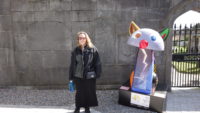 Since we have spent so much time around the year 1200 this vacation, I decided we should continue that trend. This morning we went to Kilkenny’s Medieval Mile Museum, which houses artifacts and historical items for Kilkenny, starting around, oh, let’s say 1200 (although it was a smidge before that, but who is counting?).
Since we have spent so much time around the year 1200 this vacation, I decided we should continue that trend. This morning we went to Kilkenny’s Medieval Mile Museum, which houses artifacts and historical items for Kilkenny, starting around, oh, let’s say 1200 (although it was a smidge before that, but who is counting?).
We had booked a guided tour, and I am very glad we did. It was just Meredith and I and our enthusiastic guide Sharon. She took us around the museum, which is housed in a church from 1200, and she explained what we were looking at and why it mattered. Some of the items she shared with us:
- A collection of clay pipe heads used for funerals, a tradition which still continues. She also told us the Irish wake comes from “wake up,” which occasionally happened to the “dead” before modern medicine came along. The tradition of sitting with a body for three days was to make sure the person was dead.
- A rebels’ coin minted from coffin hinges to make money for when Kilkenny was under siege and needed food and weapons.
- The tops of doorways now just peeking out of the floor. Over the years, seventy thousand people were buried in the church itself, which raised the floor level about ten feet.
- Examples of carved crypt covers that became more elaborate over time, showing Kilkenny’s growing size and wealth.
- She shared the fun fact that early Kilkenny would have spoken French because of the Anglo-Norman settlers of the city.
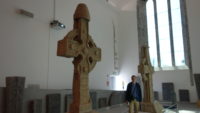 On Sharon’s recommendation, we then walked up the street about five minutes to go to St. Canice’s Cathedral, an actual non-destroyed church that is still in use. It’s probably because it is a modern church, finished in 1285. Happily, the church has an intact (except for the cone on top) round tower from around 900, so it gives it some legitimacy. And the tower is only one of two in Ireland that you can still climb. So we had to do that.
On Sharon’s recommendation, we then walked up the street about five minutes to go to St. Canice’s Cathedral, an actual non-destroyed church that is still in use. It’s probably because it is a modern church, finished in 1285. Happily, the church has an intact (except for the cone on top) round tower from around 900, so it gives it some legitimacy. And the tower is only one of two in Ireland that you can still climb. So we had to do that.
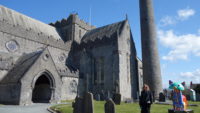 There is head knowledge, and then there is experience. My head knew the towers were very tall, joined by multiple ladders, and there wasn’t much space inside them. It’s another thing to experience climbing six separate ladder-like sets of stairs in a slowly shrinking conic cylinder. The last ladder was very steep and very tight. It certainly would have been a terrible place to be trapped by enemies, and the towers were only used as a last resort for that. You are able to climb out on top of the tower, by climbing five uneven tall stone steps. Meredith and I both managed it, and she enjoyed it as much as you can on a forty-degree day with gusting winds at the top of a tower. I huddled in the middle of the safest area for a minute before retreating to the safety of the uneven steps. I was able to keep my head above the tower to look around.
There is head knowledge, and then there is experience. My head knew the towers were very tall, joined by multiple ladders, and there wasn’t much space inside them. It’s another thing to experience climbing six separate ladder-like sets of stairs in a slowly shrinking conic cylinder. The last ladder was very steep and very tight. It certainly would have been a terrible place to be trapped by enemies, and the towers were only used as a last resort for that. You are able to climb out on top of the tower, by climbing five uneven tall stone steps. Meredith and I both managed it, and she enjoyed it as much as you can on a forty-degree day with gusting winds at the top of a tower. I huddled in the middle of the safest area for a minute before retreating to the safety of the uneven steps. I was able to keep my head above the tower to look around.
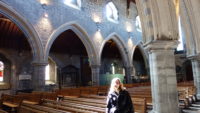 The cathedral itself is pretty and has a long history. The two objects I liked best were a set of intricate carvings on top of tombs for an important family (next to the list of the family line going back to about 1150 – the current duke/lord/whatever is the twenty-third one), and they have a stone chair that has been used to install bishops since something like 1000. And you are invited to sit in the chair.
The cathedral itself is pretty and has a long history. The two objects I liked best were a set of intricate carvings on top of tombs for an important family (next to the list of the family line going back to about 1150 – the current duke/lord/whatever is the twenty-third one), and they have a stone chair that has been used to install bishops since something like 1000. And you are invited to sit in the chair.
After lunch, we drove the hour and a half back to Dublin, where I managed to park the car in a small spot, where I can leave it until Saturday morning. That was a relief. After a quick dumping of stuff in the room, we walked the twenty minutes into the city, passing through the northern part of St. Stephen’s Green. We got supper in the Grafton Street shopping area, and then went off to the surprise of the evening for Mer – we walked up to Sweny’s Pharmacy.
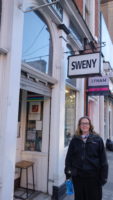 Sweny’s Pharmacy is a place that the protagonist of James Joyce’s Ulysses goes in the book. The pharmacy is now run as a Joyce landmark, and on Thursday nights, you can go into the very small shop and take turns reading out loud from the book. This seemed like something my English-teacher wife should do, and I was right – she loved it, after she got over the confusion of why I wanted her picture in front of a random small store.
Sweny’s Pharmacy is a place that the protagonist of James Joyce’s Ulysses goes in the book. The pharmacy is now run as a Joyce landmark, and on Thursday nights, you can go into the very small shop and take turns reading out loud from the book. This seemed like something my English-teacher wife should do, and I was right – she loved it, after she got over the confusion of why I wanted her picture in front of a random small store.
The gentleman who organizes it is a gentle and hospitable man who also happens to teach six languages at Trinity. He offered us wine or whiskey and chatted with us for some time. He had a dry sense of humor and made us feel important. He may have given Dale, Meredith’s late father, some competition for the title of my ideal professor stereotype. He seemed like he would be a don at Oxford (if Trinity has the same title). The reading went on for about an hour and a half, and we were joined by about fifteen people in the shop and about ten people online. Not everyone was a native English speaker, and it amazes me that anyone would tackle such a difficult book in a second language. It was a joy hearing the Irish, British, American, and other accents all reading.
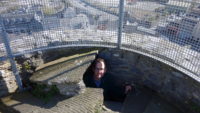 That wrapped up the day for us – we walked back to the B and B. From 1200 to 1920 – we’ve had a long day. Time for bed.
That wrapped up the day for us – we walked back to the B and B. From 1200 to 1920 – we’ve had a long day. Time for bed.